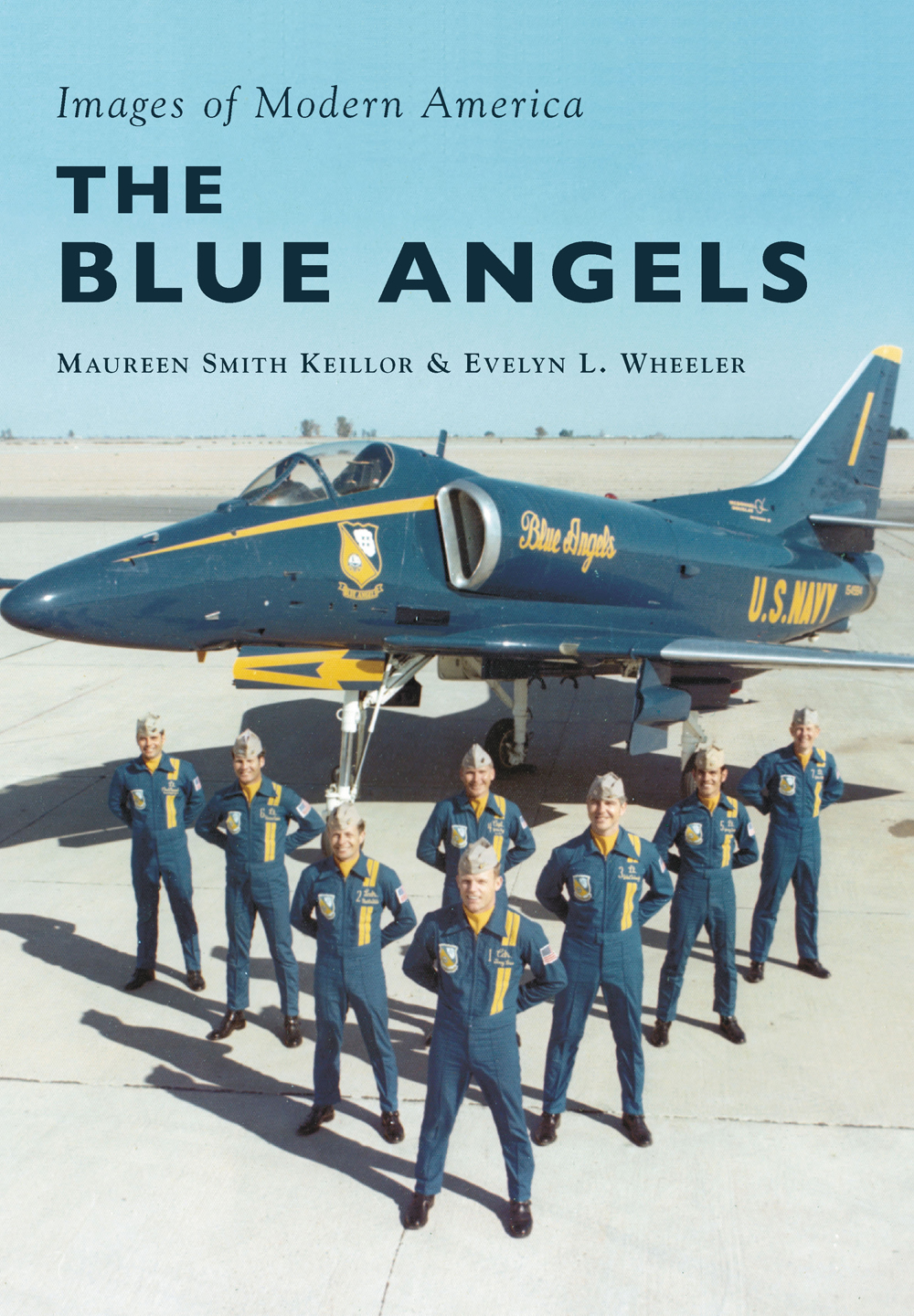
Images of Modern America
THE
BLUE ANGELS

Predecessors to the Blue Angels, the Three TGallantsls perform the farvel maneuver over Pensacola around 1929 in their Curtiss F6C-4. Note that one of the two aircraft at left is inverted. (Courtesy of Buehler Library in Pensacola, Florida.)
ON THE COVER: Members of the 1974 Blue Angels team stand in delta formation in front of their McDonnell Douglas A-4F Skyhawk. From left to right are Lt. Chuck Newcomb, public affairs officer; Lt. Vance Parker, No. 6; Lt. Comdr. Marlin Wiita, No. 2; Comdr. Tony Less, No. 1; Capt. John Fogg, No. 4 (behind Less); Lt, John Chehansky, No. 3; Lt. Jerry Tucker, No. 5 and Lt. John Patton, No. 7. (Courtesy of Buehler Library in Pensacola, Florida.)
UPPER BACK COVER: The Blue Angels team in McDonnell Douglas F/A-18 Hornets is in delta formation over Ford Island, Hawaii, during a ceremonial flyover of the Arizona Memorial. (Courtesy of Buehler Library in Pensacola, Florida.)
LOWER BACK COVER (from left to right): Pres. Gerald Ford greets the team and shakes hands with Lt. Chuck Newcomb, Blue Angel No. 8 in 1974; the Blues perform the Diamond Breakout during a practice in Pensacola in 2015; Comdr. Tony Less assumes command of the Blue Angels in 1974 with a cake-cutting ceremony at Naval Air Station (NAS) Pensacola. (All, courtesy of Buehler Library in Pensacola, Florida.)
Images of Modern America
THE
BLUE ANGELS
MAUREEN SMITH KEILLOR & EVELYN WHEELER

Copyright 2017 by Maureen Smith Keillor and Evelyn Wheeler
ISBN 978-1-4671-1747-0
Ebook ISBN 9781439659359
Published by Arcadia Publishing
Charleston, South Carolina
Library of Congress Control Number: 2016933523
For all general information, please contact Arcadia Publishing:
Telephone 843-853-2070
Fax 843-853-0044
E-mail
For customer service and orders:
Toll-Free 1-888-313-2665
Visit us on the Internet at www.arcadiapublishing.com
This book is dedicated to the men and women who have dreamed, designed, built, maintained and flown heavier than-air machines for over one hundred years.
CONTENTS
ACKNOWLEDGMENTS
As with our previous Arcadia title, Naval Air Station Pensacola, this book would not be possible without the men and women of the Emil Buehler Library at the National Naval Aviation Museum. We cannot thank them enough for their endless patience in answering questions and tracking down photographs. The Blue Angels Association was also a great help in answering the authors endless appetite for detailsparticularly Laura Bogan, Boss Anderson, Boss Wisely, Bruce Davey, and Ed Nafus. Derek Stewart of Focal Point Envelopes supplied several excellent images and can be contacted at . Many friends and family members have filled in blanks and supplied extra information, as well as been patient during the process, including Dave Kyle, David Takacs, Edmund Keillor, and especially Chief Richard Keillor, USN. Unless otherwise noted, all the photographs in this book were obtained from the Buehler Library in Pensacola, Florida.
INTRODUCTION
From the time the Wright brothers launched into history at Kitty Hawk, North Carolina, in 1903, we have been fascinated by powered flight. The US Navy Flight Demonstration Squadron, popularly known as the Blue Angels, fulfills that fascination for the public through dozens of air shows during the March-to-November air-show season. This is Americas oldest flight demonstration team, established in 1946 by Adm. Chester W. Nimitz. Millions descend annually on airfields throughout the nation, eagerly anticipating the sights, sounds, and smells of the best the Navy has to showcase.
The US Navy has been engaged in aviation since 1910, when Glenn Curtiss sent Eugene Ely soaring off a wooden makeshift platform on the deck of the USS Birmingham (CL-2) off the coast of Virginia, supported by a 50-horsepower engine. Research and development continues for the fastest, highest, and most powerful aircraft with the best and most-skilled pilots. In the years between the two world wars, the Navy and Marine Corps featured several groups who informally and unofficially performed aerobatics in groups at air races and for ceremonies. Today, the Blue Angels continue to exhibit the same skill and precision begun by the early pioneering aviators.
During World War II, those engineers developed and the aviators honed naval aviation into a force that helped America and its allies win the war. Much was learned during that critical time that is still being applied in todays Navy. After the war, the Navy sought for a way to keep public appreciation and support for naval aviation alive. A flight demonstration team could showcase the pride and professionalism of the US Navy and Marine Corps by inspiring a culture of excellence and service to country through flight demonstrations and community outreach, as the Blue Angels mission statement reads.
Showcasing Naval Aviations Pride and Professionalism began with World War II ace Roy Marlin Butch Voris and his team at Cecil Field in Jacksonville in 1946 and continues today with the men and women of the Navy and the Marine Corps. Without those who fly and maintain them, the aircraft would be nothing more than interesting things to look at. But those men and women are a dedicated group who exhibit that Pride and Professionalism, both on and off the airfields. Both officers and enlisted members of the Blue Angels have passed a rigorous standard of qualifications, serve from two to four years, and are ambassadors representing the hundreds of thousands of officers, sailors, and marines serving all over the world. The teamwork, camaraderie, and the common bond of being a Blue inspire young and old wherever the Blues fly.
From the original Hellcat to todays Hornets and, soon, Super Hornets, the Blue Angels aircraft represent the best in aviation technology. The current F/A-18 A through D models come from the fleet, and with slight modifications, could be returned to combat-ready state in 72 hours. They are capable of speeds of 1,400 miles per houralmost twice the speed of sound. The highest speed typically flown in an air show is 700 miles per hour and the slowest a mere 120 miles per hour. From the solo pilots low Sneak Pass at 50 feet above the ground to the soaring heights of the diamond and delta formations, the Hornet climbs to a level of 15,000 feet at a lightning 30,000 feet per minute.
This work is carried out in part with the help of the US Marine Corps (USMC) in the form of a Lockheed Martin C-130 Hercules painted in matching blue and gold and fondly known the world over as Fat Albert. The ancestors of Bert once served in the lowly role of workhorse, but todays shows are proudly led off by Bert in a demonstration of the power and agility of one of the most versatile aircraft in the skies. According to the Navy, Hercules aircraft are a global airlift in 40 different versions that can be used as gunships, weather watchers, tankers, fire fighters and aerial ambulances. The Herc can be configured to carry almost any combination of 45,000 pounds of cargo (which may include an armored vehicle) or 92 troops.
With each new generation of aircraft, the maneuvers become more breathtaking. From piston-driven propeller planes to turbo jets with afterburners, the Blue Angels continue to push the envelope of physical laws. With the planes often flying within 18 inches of one another at hundreds of miles per hour, many hours of practice as well as the trust and teamwork among the pilots keep the Blues safe in the sky. However, from the basic diamond formation to the breathtaking Knife-edge Pass, those maneuvers are not stunts, but tactical combat moves that any qualified aviator in the US Navy performs on a regular basis in the fleet.
Next page












